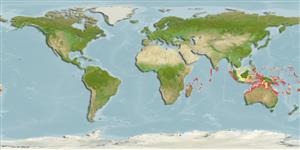Common names from other countries
>
Ovalentaria/misc (Various families in series Ovalentaria) >
Pomacentridae (Damselfishes) > Pomacentrinae
Etymology: Pomacentrus: Greek, poma, -atos = cover, operculum + Greek, kentron = sting (Ref. 45335).
More on author: Tanaka.
Environment: milieu / climate zone / depth range / distribution range
Écologie
marin récifal; océanodrome (Ref. 51243); profondeur 3 - 35 m (Ref. 1602). Tropical; 10°N - 25°S
Indo-West Pacific: Maldives (Ref. 30829) and Sri Lanka to Vanuatu, north to southern Japan; south to northwestern Australia and New Caledonia.
Taille / Poids / Âge
Maturity: Lm ? range ? - ? cm
Max length : 11.0 cm TL mâle / non sexé; (Ref. 90102)
Description synthétique
Clés d'identification | Morphologie | Morphométrie
Épines dorsales (Total) : 13; Rayons mous dorsaux (Total) : 15 - 16; Épines anales: 2; Rayons mous anaux: 15 - 16.
Adults are found in sandy areas of both lagoon and seaward reefs. They occur in small groups with outcrops of soft coral patches or gorgonians, usually in depths over 20 m (Ref. 48636). Feed primarily on zooplankton. Oviparous, males guard the nest (Ref. 59303). Eggs are demersal and adhere to the substrate (Ref. 205). Diurnal species (Ref. 54980; 113699).
Life cycle and mating behavior
Maturities | Reproduction | Spawnings | Egg(s) | Fecundities | Larves
Courtship behavior during breeding includes signal jumps, enticement, chasing and skimming (Ref. 59303).
Allen, G.R., 1991. Damselfishes of the world. Mergus Publishers, Melle, Germany. 271 p. (Ref. 7247)
Statut dans la liste rouge de l'IUCN (Ref. 130435)
CITES (Ref. 128078)
Not Evaluated
Menace pour l'homme
Harmless
Utilisations par l'homme
Pêcheries: commercial; Aquarium: Commercial
Outils
Articles particuliers
Télécharger en XML
Sources Internet
Estimates based on models
Preferred temperature (Ref.
115969): 24.7 - 28.9, mean 27.6 (based on 388 cells).
Phylogenetic diversity index (Ref.
82804): PD
50 = 0.5000 [Uniqueness, from 0.5 = low to 2.0 = high].
Bayesian length-weight: a=0.01479 (0.00642 - 0.03409), b=3.00 (2.80 - 3.20), in cm Total Length, based on LWR estimates for this (Sub)family-body shape (Ref.
93245).
Niveau trophique (Ref.
69278): 2.7 ±0.31 se; based on food items.
Résilience (Ref.
120179): Haut, temps minimum de doublement de population inférieur à 15 mois (Preliminary K or Fecundity.).
Fishing Vulnerability (Ref.
59153): Low vulnerability (10 of 100).
